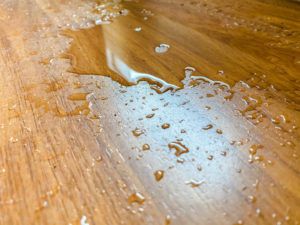Water Damage Restoration On Different Types of Flooring
 Whether your home suffers water damage from a leaky pipe or a flooded appliance, one area that is almost always affect is your flooring. Water collects on the floors, and is then left to be absorbed by your flooring material until it is extracted and dried. Regardless of the cause, size, or scope of your water damage situation, your floors need to be dried out as quickly as possible to prevent costly damage or potential replacements. Not sure what to do for your specific floor type? We are going to review some common flooring materials and how you should respond to water damage for each one.
Whether your home suffers water damage from a leaky pipe or a flooded appliance, one area that is almost always affect is your flooring. Water collects on the floors, and is then left to be absorbed by your flooring material until it is extracted and dried. Regardless of the cause, size, or scope of your water damage situation, your floors need to be dried out as quickly as possible to prevent costly damage or potential replacements. Not sure what to do for your specific floor type? We are going to review some common flooring materials and how you should respond to water damage for each one.
Water Damage Restoration In Tuscaloosa
Laminate Floors
Laminate floors are a popular option in homes today because they are more water resistant than other flooring materials, and are durable and affordable. With minor cases, water can be mopped or dried up off the surface of the floor, and that is the end of it. That being said, water damage becomes a serious issue with laminate floors when it goes untreated or gets underneath the laminate planks. Water damage will often cause laminate floors to swell which results in separation and lifting from the subfloor beneath them. The only way to fix this problem is to remove all the water and then dry out the area thoroughly. In order to completely dry the floor, even the subfloor, you may need to allow several days with commercial-grade air movers circulating air throughout the area. Since laminate floors are often laid together like a puzzle piece, pulling up just the affected planks and replacing them is not an ideal or popular option – it is hard to get the new planks to lay flush with the existing ones once you remove them. This is why it is important to dry out water damage before it gets to the subfloors. The good news though is the professionals at Restoration 1 of Tuscaloosa know how to quickly dry out water damage, and have experience with treating, replacing, and restoring water damaged laminate floors.
Vinyl Floors
Vinyl floors are relatively waterproof and can handle water and moisture extremely well, especially when installed correctly. Most of the time you can wipe up the water, or even utilize a wet/dry vacuum to remove surface water, and resolve the problem like that. However, there are cases where extensive water damage, or water damage that has been present for extended amounts of time, can cause major problems with vinyl floors. Water damage may cause vinyl planks to fade in color or warp, pulling them away from the subfloor and allowing water to seep underneath them. When water gets underneath vinyl flooring, it can become a serious problem not only for your subfloors, but also for the vinyl planks. When you call Restoration 1 of Tuscaloosa as soon as you need water damage restoration, we will be able to remove the water quickly and evaluate your vinyl floors to ensure that no further damage found its way underneath the flooring.
Wood Floors
Hardwood flooring is the most susceptible to water damage because it is so porous. Wood floors will swell, cup, buckle, crack, crown, and fade after being exposed to water, and may not be salvageable if the water damage restoration is not done right away. Restoring wood floors may involve removing, reattaching, sanding, and staining in order to get them back to their pre-loss condition, and trusting the professionals at Restoration 1 of Tuscaloosa is the best thing you can do to ensure the best possible outcome for your wood floors.
